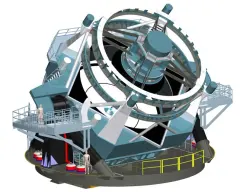The Photometric LSST Astronomical Time-Series Classification Challenge (PLAsTiCC) is a community-wide challenge to spur development of algorithms to classify astronomical transients. The Large Synoptic Survey Telescope (LSST) will discover tens of thousands of transient phenomena every single night. To deal with this massive onset of data, automated algorithms to classify and sort astronomical transients are crucial.
PLAsTiCC, based on the highly successful Supernova Photometric Classification Challenge, will consist of a set of realistic LSST simulations of a variety of transient and variable phenomena. The challenge will be publicly available on a popular data science platform, encouraging algorithm submissions from outside the Astronomy community.
PLAsTiCC ran on Kaggle. The data have now been unblinded on Zenodo, including a note on the data.
For those wanting to have a dig around post-challenge, also you can also take a look at the original data note outlining the challenge , the note on metrics for astronomical classification challenges, and our handy starter kit for those interested in working with the data.
21 January 2019
PLAsTiCC is unblinded!
The data have now been unblinded on Zenodo, including a note on the data.
More info is contained on the page about the unblinded data
29 May 2018
Updates on PLAsTiCC preparation!
We’re happy to announce that the preliminary dataset for the Photometric LSST Astronomical Time-series Classification Challenge (PLAsTiCC) has been submitted to Kaggle.
While the data has been scrutinized heavily internally, Kaggle’s data scientists will begin their own validation of the dataset, and PLAsTiCC team members will work with Kaggle to address any remaining concerns.
We aim to begin the public challenge on Kaggle in midsummer, and it will run for three months through Fall 2018 (exact dates are under negotiation).
Many thanks to the (for the present, anonymous) model contributors from LSST Dark Energy Science Collaboration (DESC) and LSST Transient and Variable Stars Science Collaboration (TVS).
The ball is rolling, and we look forward to many teams contributing their classifiers!
Get started!
The RAMP starting kit for supernova classification uses data from the 2010 Supernova Photometric Classification Challenge.
It was developed to help those interested in knowing a little more about the transient classification problem, and the light curve data, before the release of PLAsTiCC.
Meetings
Details of the first PLAsTiCC workshop, held at the Flatiron institute in July 2017, are here: First PLAsTiCC workshop
The second PLAsTiCC workshop was held at SLAC in February 2018 and the details are here: Second PLAsTiCC workshop
The third PLAsTiCC workshop took place at New York University in April 2018 and the details are here: Third PLAsTiCC workshop
More details about PLAsTiCC and the initial call for submission of transient models is here: Call for Notices of Intent: PLAsTiCC
